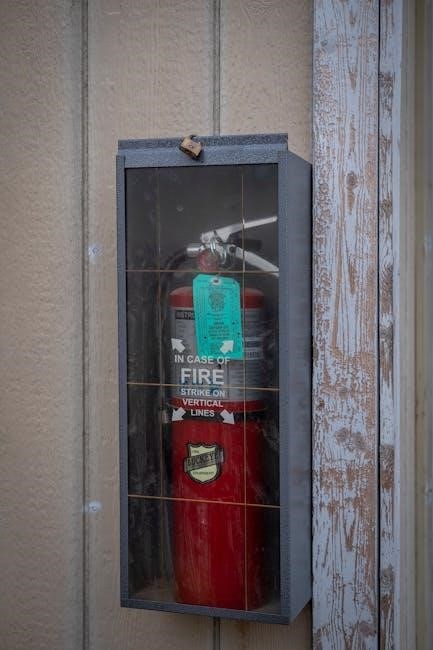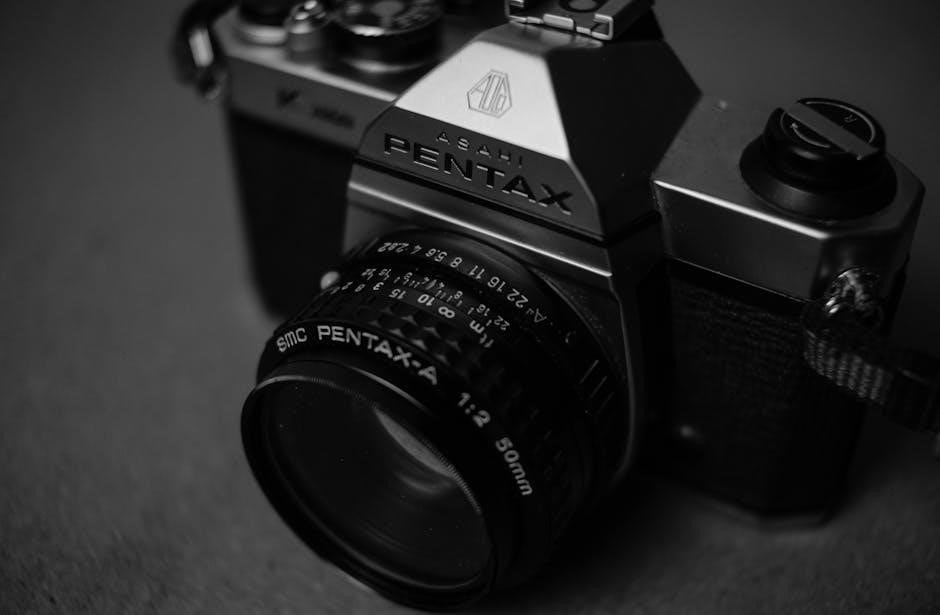
The First Alert Model 9120B is an AC-powered ionization smoke alarm with battery backup, silence function, and interconnectivity․ It offers reliable fire detection and compliance with safety standards․
1․1 Overview of the First Alert 9120B Smoke Alarm
The First Alert 9120B is a state-of-the-art smoke alarm featuring AC power with battery backup, ionization technology, and a silence function․ It includes a dust cover for construction protection and improved UV resistance․ Designed for easy installation, it ensures reliable fire detection and meets essential safety standards for home protection․
1․2 Key Features and Benefits
The First Alert 9120B boasts AC power with battery backup, ensuring uninterrupted operation․ Its ionization sensor detects small smoke particles, ideal for flaming fires․ Features include a silence button, latching alarm indicator, and interconnectivity with other compatible units․ The Perfect Mount system simplifies installation, while improved UV resistance prevents discoloration, enhancing durability and performance․
1․3 Importance of Proper Installation and Maintenance
Proper installation ensures the First Alert 9120B functions correctly, providing early fire detection․ Regular maintenance, like cleaning the sensor and replacing batteries, is crucial for reliability․ Failure to follow guidelines may result in reduced effectiveness or false alarms, compromising home safety․ Always refer to the manual for specific instructions and safety precautions․

System Requirements and Compatibility
The First Alert 9120B requires 120V AC power and is compatible with standard 4-inch junction boxes․ It supports interconnectivity with up to 18 devices and is UV-resistant․
2․1 Electrical Specifications
The First Alert 9120B operates on 120V AC power at 60 Hz, drawing 0․04A of current․ It includes a 9-volt battery backup for continuous operation during power outages, ensuring uninterrupted fire detection․
2․2 Compatibility with Other Smoke Alarm Models
The First Alert 9120B is compatible with select BRK and First Alert smoke and carbon monoxide alarms, enabling interconnected systems for whole-home protection․ It works with models like SC6120B and SA4120B, ensuring synchronized alerts and enhanced safety through seamless integration․
2․3 Interconnectivity Options
The First Alert 9120B supports interconnectivity, allowing connection to up to 18 compatible smoke and carbon monoxide alarms․ Using the orange wire, it enables synchronized alerts across all linked units․ This feature enhances whole-home safety by ensuring all alarms sound simultaneously when smoke is detected․ Proper wiring and compatibility with BRK models are essential for reliable operation․

Installation Guide
Install the First Alert 9120B smoke alarm on a standard 4-inch junction box․ Tools needed include a screwdriver and pliers․ Mount the bracket, connect wires, and ensure proper alignment․ Turn off power before starting to avoid electrical shock․ Follow manual instructions for secure mounting and wiring․
3․1 Tools and Materials Needed
For installing the First Alert 9120B smoke alarm, you’ll need a flathead screwdriver, needle-nose pliers, or a utility knife․ Additional materials include wire nuts, a junction box, and screws․ Ensure the junction box is 4-inch standard․ Keep the user manual handy for reference․ Proper tools ensure a secure and correct installation․ Safety first․
3․2 Step-by-Step Installation Instructions
Turn off power at the circuit breaker․ 2․ Mount the bracket to a 4-inch junction box․ 3․ Connect wires: black to hot, white to neutral, and orange to interconnect․ 4․ Plug in the power connector․ 5․ Attach the alarm to the bracket․ 6․ Test the alarm and ensure proper operation․ Refer to the manual for detailed diagrams and safety precautions․
3․3 Mounting and Alignment Tips
Mount the alarm on a 4-inch junction box, ensuring it is level․ Rotate the base for perfect alignment and secure it firmly․ Use a spirit level to confirm proper positioning․ The Perfect Mount System allows for fine-tuning on walls or ceilings, ensuring the alarm is straight and securely fastened for optimal performance and reliability․
3․4 Common Installation Mistakes to Avoid
Avoid installing near noisy power sources like appliances or fluorescent lights, as they may damage the alarm․ Ensure proper wire connections, especially the orange interconnect wire, and avoid crossing hot or neutral wires․ Mount the alarm level and secure it tightly to prevent misalignment․ Never restore power before completing installation to avoid electrical shock risks․

Maintenance and Troubleshooting
Regularly clean the alarm to prevent dust buildup and test it weekly․ Troubleshoot issues like false alarms by checking connections and ensuring proper installation․ Address battery-related problems promptly to maintain reliability and safety․
4․1 Regular Maintenance Tips
Regularly clean the smoke alarm to prevent dust buildup using a vacuum or soft brush․ Test the alarm weekly by pressing the Test/Silence button․ Ensure the battery is fresh, replacing it every 6 months or when the low-battery warning sounds․ Check all connections and ensure proper installation to maintain optimal performance and safety․
4․2 Troubleshooting Common Issues
Check power connections and ensure the green power light is on․ Clean the sensor with a soft brush or vacuum to remove dust․ If the alarm chirps, replace the battery or check connections․ For false alarms, press the Test/Silence button to reset․ Ensure proper installation and alignment to avoid issues․ Consult the manual for detailed solutions if problems persist․
4․3 Battery Replacement and Care
Replace the 9-volt battery annually or when the low-battery chirp sounds․ Use high-quality alkaline batteries for optimal performance․ The Side Load Battery Drawer allows easy replacement without removing the alarm․ Avoid using rechargeable batteries․ Ensure the battery is securely connected to maintain proper function․ Replace the battery every 10 years as part of regular maintenance․

Understanding the Technology
The First Alert 9120B uses ionization technology to detect smoke particles․ It excels at identifying small particles from flaming fires, offering quick detection for rapid fire spread scenarios․
5․1 Ionization Technology Explained
The First Alert 9120B employs ionization technology, which uses a small electric current to detect smoke particles․ It ionizes air molecules, creating a current that drops when smoke disrupts the flow, triggering the alarm․ This technology is highly sensitive to small smoke particles, typically produced by fast-spreading, flaming fires, ensuring rapid detection and early warning․ It meets UL 217 standards for reliability and effectiveness in fire safety․
5․2 How Smoke Detection Works
The First Alert 9120B detects smoke through ionization technology․ Smoke particles enter the sensor chamber, disrupting the ionization current․ This triggers the alarm, alerting residents to potential fires․ The sensor is designed to detect both visible and invisible particles, ensuring early warning for various types of fires, including those producing dense smoke or rapid flames․
5․3 Differences Between Ionization and Photoelectric Alarms
Ionization alarms, like the First Alert 9120B, detect small smoke particles from fast-flaming fires․ Photoelectric alarms detect larger particles from smoldering fires․ Ionization alarms respond faster to open flames, while photoelectric alarms reduce nuisance alarms from cooking smoke․ Both technologies protect against different fire types, offering tailored safety solutions for various scenarios․

Safety Tips and Best Practices
Test smoke alarms weekly, keep them clean, and avoid installing near cooking areas․ Never paint alarms or disable them․ Replace every 10 years for optimal safety․
6․1 Recommended Locations for Smoke Alarms
Install smoke alarms on every level of your home, inside sleeping areas, and outside adjacent rooms․ Place them on ceilings or walls, at least 10 feet from cooking appliances․ Avoid areas near bathrooms, AC vents, or fluorescent lights․ Ensure alarms are audible to all residents and interconnected for maximum safety․
6․2 Fire Safety Tips for Homeowners
Test smoke alarms weekly and replace every 10 years․ Keep flammable materials away from heat sources, store combustibles properly, and ensure electrical appliances are in good condition․ Avoid overloaded circuits, keep emergency exits clear, and maintain functional fire extinguishers on each floor․ Stay vigilant and never smoke in bed or near flammable materials․
6․3 Compliance with Fire Safety Regulations
Ensure smoke alarms meet local fire codes and regulations․ Install alarms on every level and in each sleeping area․ Replace alarms every 10 years, as recommended by the NFPA․ Maintain proper installation and testing to ensure compliance with standards like UL217, ensuring reliable fire detection and early warning systems for your home․

Advanced Features and Settings
The First Alert 9120B features a silence function to mute false alarms, latching features to identify triggering alarms, and interconnectivity for whole-home protection․ Improved UV resistance ensures durability․
7․1 Silence Function and Latching Features
The First Alert 9120B includes a Silence Function to temporarily mute nuisance alarms, such as those triggered by cooking smoke․ The Latching Feature identifies the initiating alarm by keeping its LED lit after the condition clears, aiding in interconnected systems․ These features enhance usability and simplify troubleshooting without compromising safety․
7․2 Interconnected Alarm Systems
The First Alert 9120B supports interconnectivity, allowing multiple alarms to link via an orange wire․ When one alarm detects smoke, all interconnected units sound simultaneously․ This feature enhances safety by ensuring complete home coverage․ Proper wiring and connection to the junction box are essential for reliable operation across all linked devices․
7․3 Customizing Your Smoke Alarm Settings
The First Alert 9120B allows customization to suit your needs․ Use the Test/Silence button to silence nuisance alarms or test functionality․ The latching feature identifies initiating alarms post-condition․ Adjustments can be made to minimize false alarms, and the battery pull tab ensures freshness․ These settings enhance user experience and system reliability․

Technical Specifications
The First Alert 9120B operates on 120V AC, 60 Hz, 0․04A, with UL217 certification․ It includes a 9-volt battery and dust cover for protection during construction․
8․1 Power Requirements and Consumption
The First Alert 9120B requires 120V AC, 60 Hz, 0․04A power․ It includes a 9-volt battery backup for continuous operation during power outages․ The alarm is UL217 certified, ensuring reliability and safety․ The green power indicator confirms proper AC power connection, while the battery backup maintains functionality when primary power is lost․
8․2 Dimensions and Weight
The First Alert 9120B smoke alarm is compact and lightweight, designed for standard installations․ Its dimensions and weight are optimized for easy mounting on walls or ceilings, ensuring minimal space usage while maintaining reliability and performance․ Exact measurements are not specified in the manual, but the design ensures seamless integration into any home setup․
8․3 Certifications and Compliance Standards
The First Alert 9120B smoke alarm meets rigorous safety standards, including UL 217 certification, ensuring reliable fire detection․ It complies with key regulations, offering homeowners trusted protection and peace of mind through its adherence to industry benchmarks for smoke alarms․

User Manual Highlights
The manual provides detailed guidance on installation, maintenance, and troubleshooting, ensuring safe and effective use of the First Alert 9120B smoke alarm, along with warranty information․
9․1 Navigating the User Manual
The user manual for the First Alert 9120B is organized for easy navigation, featuring sections on installation, maintenance, and troubleshooting․ It includes a table of contents, detailed diagrams, and step-by-step guides to ensure proper setup and operation․ The manual also provides safety precautions, warranty information, and FAQs to address common user queries effectively․
- Clear instructions for installation and maintenance․
- Detailed troubleshooting guides for common issues․
- Important safety notes and compliance standards․
9․2 Important Safety Information
The manual emphasizes critical safety precautions, such as ensuring the alarm is properly installed and maintained․ It warns against painting the unit or installing it near cooking areas to avoid false alarms․ Regular testing is stressed to ensure functionality, and users are advised to replace the alarm every 10 years․
- Avoid installing near kitchens or bathrooms․
- Never paint the smoke alarm․
- Replace the unit every 10 years․
9․3 Warranty and Support Information
The First Alert Model 9120B is backed by a limited warranty covering defects in materials and workmanship․ For support, users can access online resources, troubleshooting guides, and customer service through the official website; Detailed warranty terms and contact information are provided in the manual․
- Limited warranty covers manufacturing defects․
- Online support and troubleshooting available․
- Refer to the manual for full warranty details․
Common FAQs
Common FAQs cover installation, troubleshooting, and maintenance tips․ They provide practical solutions and insights to ensure optimal performance and address user concerns effectively․
10․1 Frequently Asked Questions About Installation
Common installation questions include turning off power first, using needle-nose pliers for wire connections, and ensuring proper mounting alignment․ Ensure the junction box is compatible and wires are securely connected to avoid electrical issues and ensure proper functionality․
10․2 Troubleshooting and Maintenance FAQs
Common issues include false alarms, which can be resolved by cleaning the sensor or checking for cooking fumes․ The red LED blinking indicates a problem․ Regularly dust the alarm and replace batteries annually․ Ensure connections are secure and test the alarm weekly․ Replace the unit every 10 years for optimal performance․
10․3 General Usage and Safety FAQs
Test the alarm weekly and ensure it’s clean from dust․ Never disable the alarm permanently; use the silence feature only temporarily․ Keep the unit away from cooking areas to avoid false alarms․ Replace batteries annually and the alarm every 10 years․ Ensure compliance with local fire safety codes for optimal protection․
The First Alert Model 9120B is a reliable smoke alarm offering robust fire detection, ease of use, and essential safety features․ Proper installation and maintenance ensure optimal performance and protection․
11․1 Final Thoughts on the First Alert 9120B
The First Alert 9120B stands out as a reliable smoke alarm, combining ionization technology with essential features like battery backup and interconnectivity․ Its UL217 certification ensures compliance with safety standards, while its user-friendly design simplifies installation and maintenance․ With its robust performance and early fire detection capabilities, it remains a top choice for home safety․
11․2 Importance of Proper Usage and Maintenance
Proper usage and maintenance of the First Alert 9120B are crucial for ensuring its effectiveness․ Regular testing and cleaning help maintain sensitivity․ Replacing worn-out parts and checking battery levels prevent false alarms․ Following the manual ensures correct installation and operation․ Neglecting these steps can reduce the alarm’s reliability, compromising home safety and protection․
11․3 Resources for Further Assistance
For additional help, visit First Alert’s official website or BRK Electronics for detailed manuals, FAQs, and troubleshooting guides․ Contact customer support for personalized assistance․ The user manual provides comprehensive installation and maintenance tips, ensuring optimal performance and safety compliance for the First Alert 9120B smoke alarm․